BUICK PARK AVENUE 1993 Service Manual
Manufacturer: BUICK, Model Year: 1993, Model line: PARK AVENUE, Model: BUICK PARK AVENUE 1993Pages: 340, PDF Size: 18.17 MB
Page 41 of 340
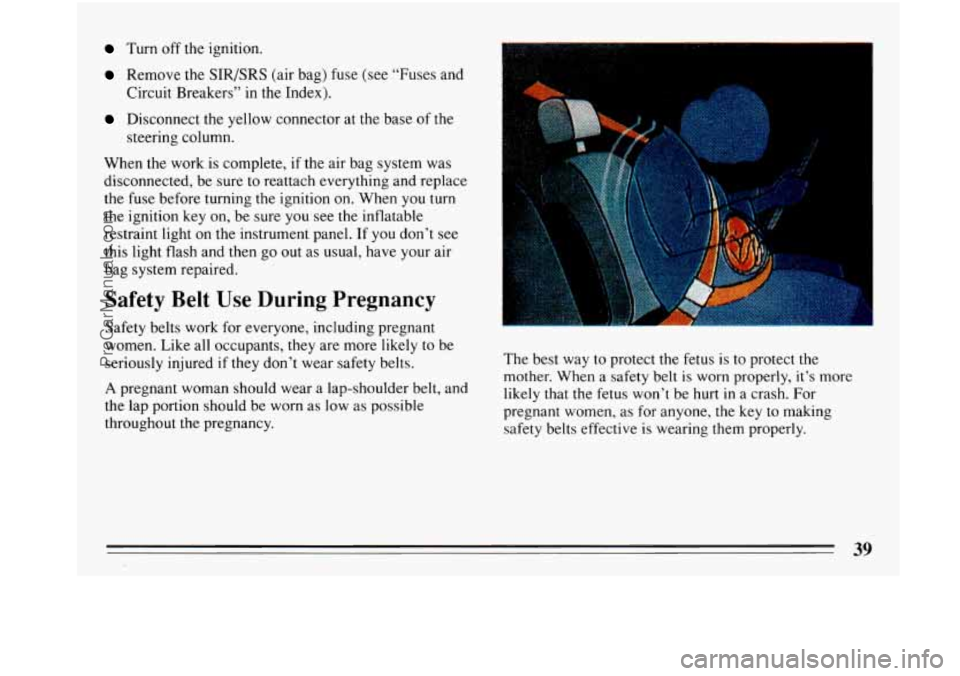
Turn off the ignition.
Remove the SlR/SRS (air bag) fuse (see “Fuses and
Circuit Breakers” in the Index).
Disconnect the yellow connector at the base of the
steering column.
When the work is complete, if the air bag system was
disconnected, be sure to reattach everything and replace
the fuse before turning the ignition on. When you turn
the ignition key on, be sure
you see the inflatable
restraint light
on the instrument panel. If you don’t see
this light flash and then go
out as usual, have your air
bag system repaired.
Safety Belt Use During Pregnancy
Safety belts work for everyone, including pregnant
women. Like all occupants, they are more likely
to be
seriously injured if
they don’t wear safety belts.
A pregnant woman should wear a lap-shoulder belt, and
the lap portion should be worn as low
as possible
throughout the pregnancy. The best way
to protect the fetus is to protect the
mother. When a safety belt
is worn properly, it’s more
likely that the fetus won’t be hurt in a crash. For
pregnant women, as for anyone,
the key to making
safety belts effective is wearing them properly.
ProCarManuals.com
Page 42 of 340
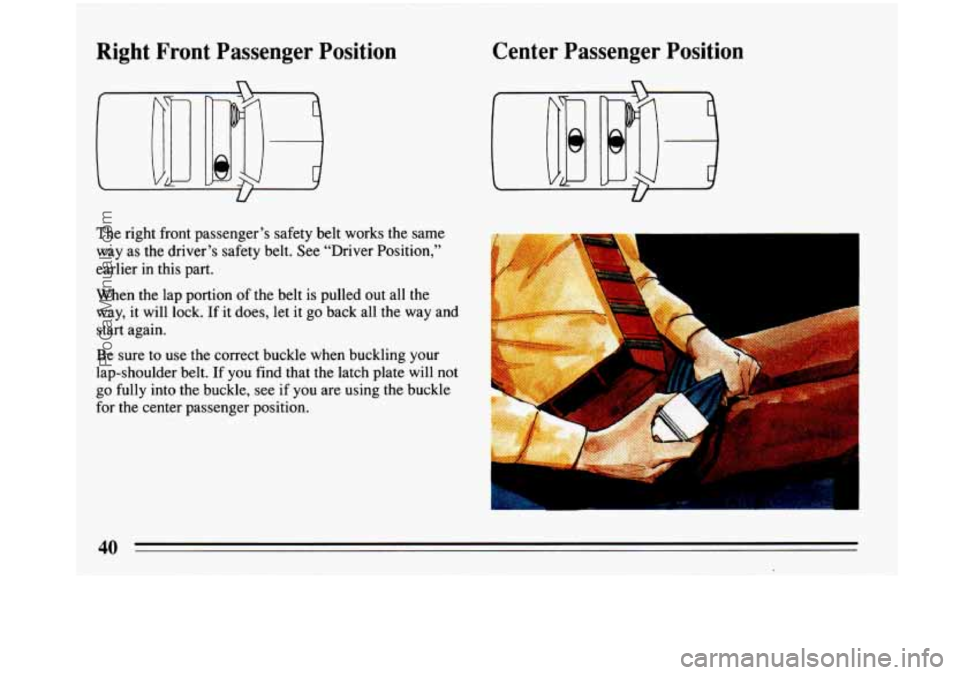
Right Front Passenger Position Center
Passenger Position
n
U
The right front passenger’s safety belt works the same
way as the driver’s safety belt. See “Driver Positi,on,”
earlier in this part.
When the lap portion
of the belt is pulled out all the
way, it will lock. If it does, let it
go back all the way and
start again.
Be sure to use the correct buckle when buckling your
lap-shoulder belt. If you find that the latch plate will not
go fully into the buckle, see if you are using the buckle
for the center passenger position.
I
U
i
ProCarManuals.com
Page 43 of 340
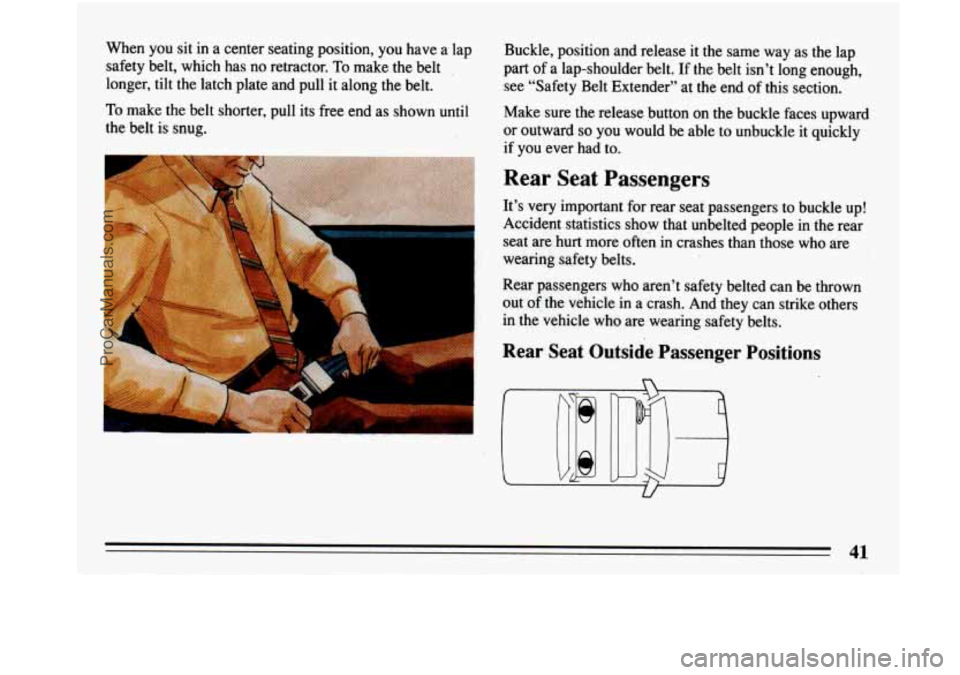
When you sit in a center seating position, you have a lap
safety belt, which has no retractor.
To make the belt
longer, tilt the latch plate and pull it along the belt.
To make the belt shorter, pull its free end as shown until
the belt is snug. Buckle, position
and release it the same way as the lap
part of a lap-shoulder belt.
If the belt isn’t long enough,
see “Safety Belt Extender’’ at the end of this section.
Make sure the release button on the buckle faces upward
or outward
so you would be able to unbuckle it quickly
if you ever had to.
Rear Seat Passengers
It’s very important for rear seat passengers to buckle up!
Accident statistics show that unbelted people in the rear
seat are hurt more
often in crashes than those who are
wearing safety belts.
Rear passengers who aren’t safety belted can be thrown
out
of the vehicle in a crash. And they can strike others
in the vehicle who are wearing safety belts.
Rear Seat Outside Passenger P.ositions
41
ProCarManuals.com
Page 44 of 340
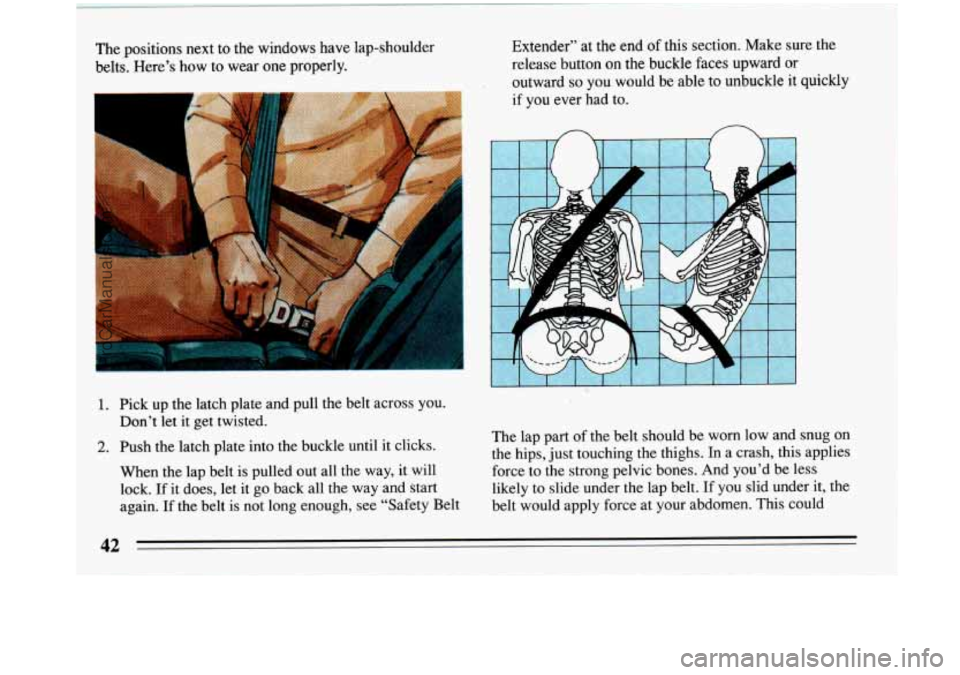
The positions next to the windows have lap-shoulder
belts. Here’s how to wear
one properly.
-
Extender” at the end of this section, Make sure the
release button
on the buckle faces upward or
outward
so you would be able to unbuckle it quickly
if you ever had to.
n n
1. Pick up the latch plate and pull the belt across you.
2. Push the latch plate into the buckle until it clicks.
When the lap belt is pulled out all the way, it will
lock.
If it does, let it go back all the way and start
again. If the belt is not long enough, see “Safety Belt
Don’t let it
get twisted.
The lap part of the belt should be worn low and snug on
the hips, just touching the thighs.
In a crash, this applies
force to the strong pelvic bones. And you’d be less
likely to slide under the lap belt. If you slid under it, the
belt would apply force at your abdomen. This could
ProCarManuals.com
Page 45 of 340
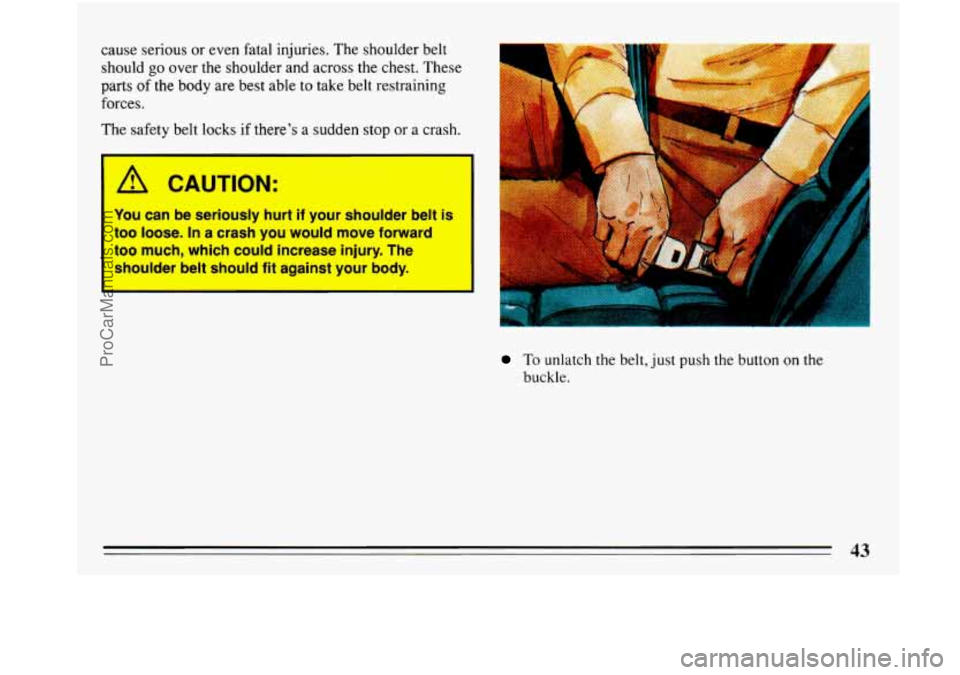
cause serious or even fatal injuries. The shoulder belt
should go over the shoulder and across the chest. These
parts of the body are best able to take belt restraining
forces.
The safety belt
locks if there’s a sudden stop or a crash.
I A CAUTION:
I
You can be seriously hurt if your shoulder belt is
too loose. In a crash you would move forward
too much, which could increase injury. The shoulder belt should fit against your body.
I
To unlatch the belt, just push the button on the
buckle.
43
ProCarManuals.com
Page 46 of 340
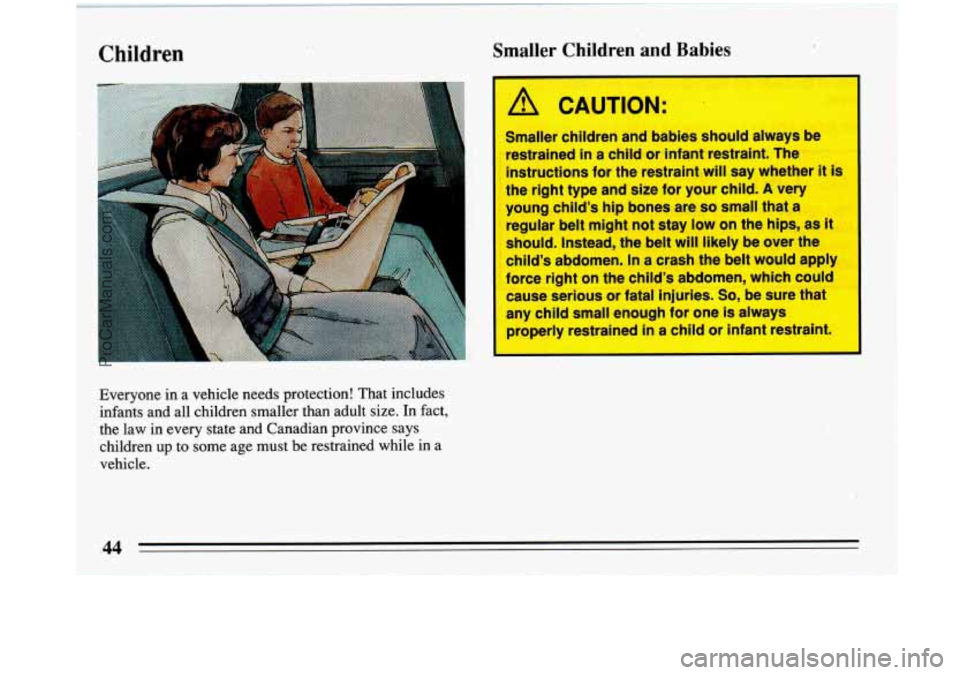
Children
Everyone in. a vehicle needs protection! That includes
infants and all children smaller than adult size.
In fact,
the law in every state and Canadian province says
.
children up to some age must be restrained while in a
vehicle.
Smaller Children and Babies
A CAUTION:
Smaller children and babies should always be
restrained
in a child or infant restraint. The
instructions for the restraint will say whether
it is
the right type and size for your child. A very
young child's hip bones are
so small that a
regular belt might not stay low on the hips, as
it
should. Instead, the belt will likely be over the
child's abdomen.
In a crash the belt would apply
force right on the child's abdomen, which could
cause serious or fatal injuries.
So, be sure that
any child small enough for one is always
properly restrained
in a child or infant restraint.
44
ProCarManuals.com
Page 47 of 340
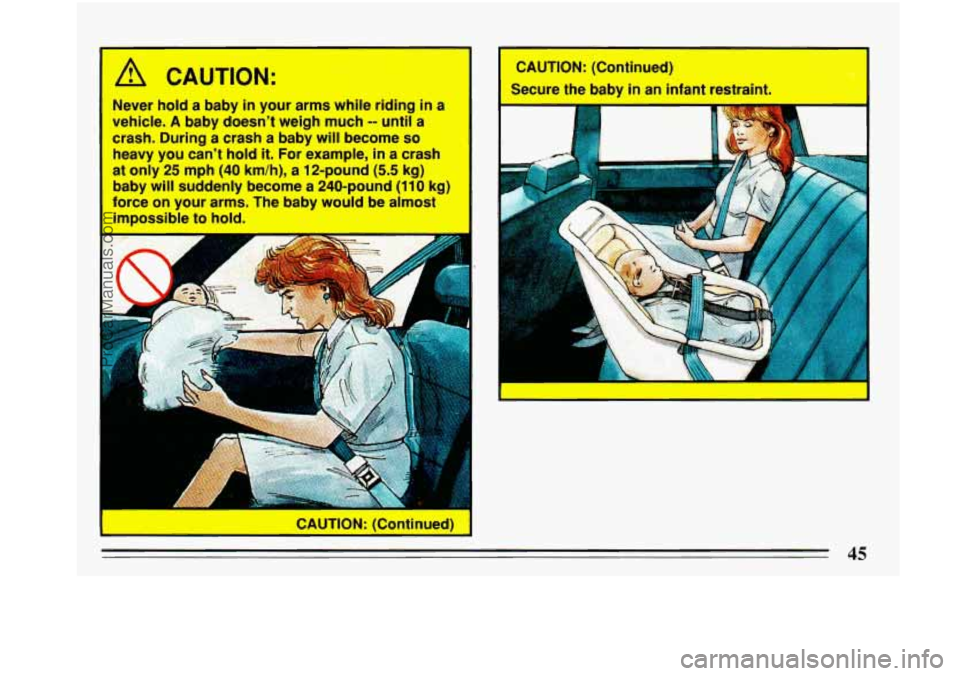
f
A CAUTION:
Never hold a baby in your arms white riding in a
vehicle. A baby doesn’t weigh much
-- until a
crash. During a crash a baby will become
so
heavy you can’t hold it. For example, in a crash
at only
25 mph (40 km/h), a 12-pound (5.5 kg)
baby will suddenly become
a 240-pound (110 kg)
force on your arms. The baby would be almost
impossible to hold.
(Continuec
I I1 CAUTION: (Continued)
I Secure the baby in an infant restraint. I
L
ProCarManuals.com
Page 48 of 340
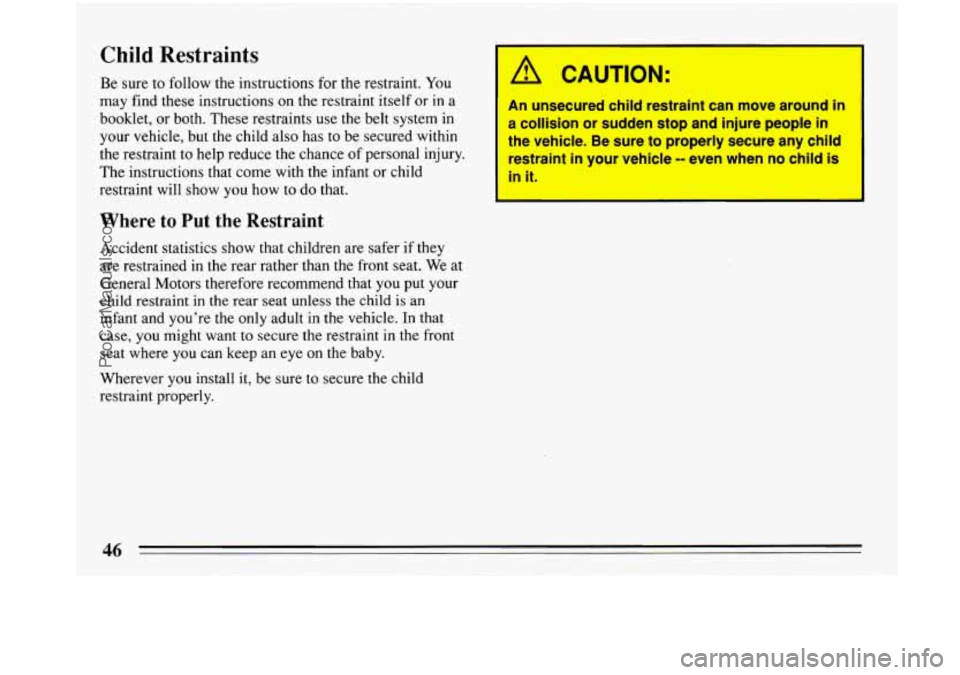
Child Restraints
Be sure to follow the instructions for the restraint. You
may find these instructions
on the restraint itself or in a
booklet, or both. These restraints use the belt system in
your vehicle, but the child also has
to be secured within
the restraint to help reduce the chance
of personal injury.
The instructions that come with the infant or child
restraint will show you how to do that.
Where to Put the Restraint
Accident statistics show that children are safer if they
are restrained in the rear rather than the front seat. We
at
General Motors therefore recommend that you put your
child restraint in the rear
seat unless the child is an
infant and you’re the
only adult in the vehicle. In that
case, you might want to secure the restraint in the front
seat where you can keep an eye on the baby.
Wherever you install it, be sure
to secure the child
restraint properly.
i A CAUTION: I
~ An unsecured child restraint can move around in
a collision or sudden stop and injure people in
the vehicle. Be sure to properly secure any chiP
restraint in your vehicle
-- even when no child i,
ProCarManuals.com
Page 49 of 340
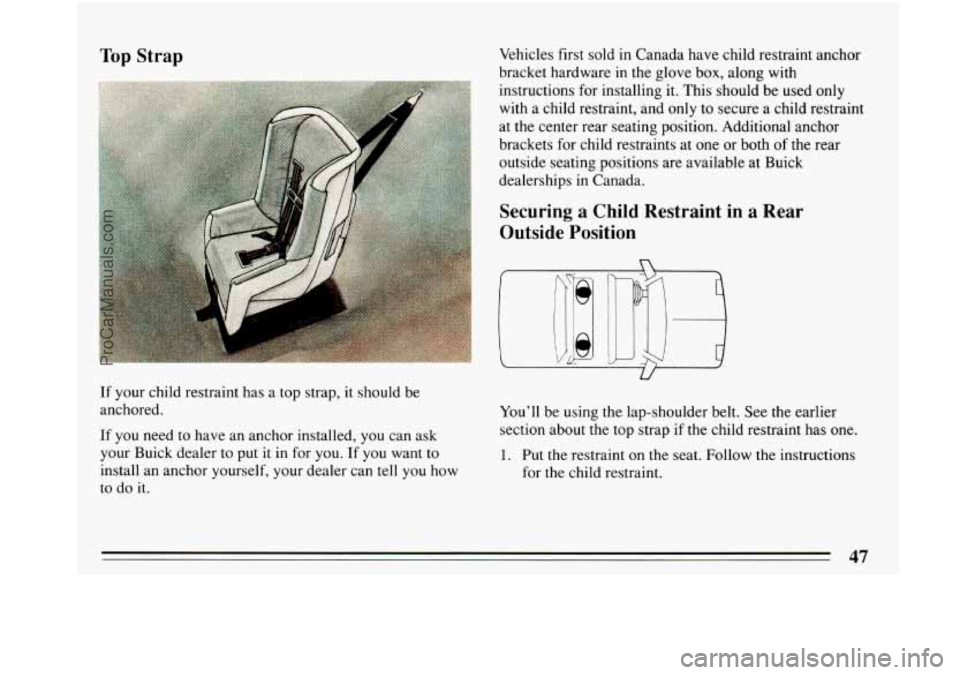
Top Strap Vehicles first sold in Canada have child restraint anchor
bracket hardware in the glove box, along with
instructions for installing it. This should be used only
with a child restraint, and only to secure
a child restraint
at the center rear seating position. Additional anchor
brackets for child restraints at one or both
of the rear
outside seating positions are available at Buick
dealerships in Canada.
If your child restraint has a top strap, it should be
anchored.
If you need to have an anchor installed, you can ask
your Buick dealer to put it in for
YOU. If you want to
install an anchor yourself, your dealer can tell
you how
to do it.
Securing a Child Restraint in a Rear
Outside Position
You’ll be using the lap-shoulder belt. See the earlier
section about the top strap if the child restraint has one.
1. Put the restraint on the seat. Follow the instructions
for the child restraint.
47
ProCarManuals.com
Page 50 of 340
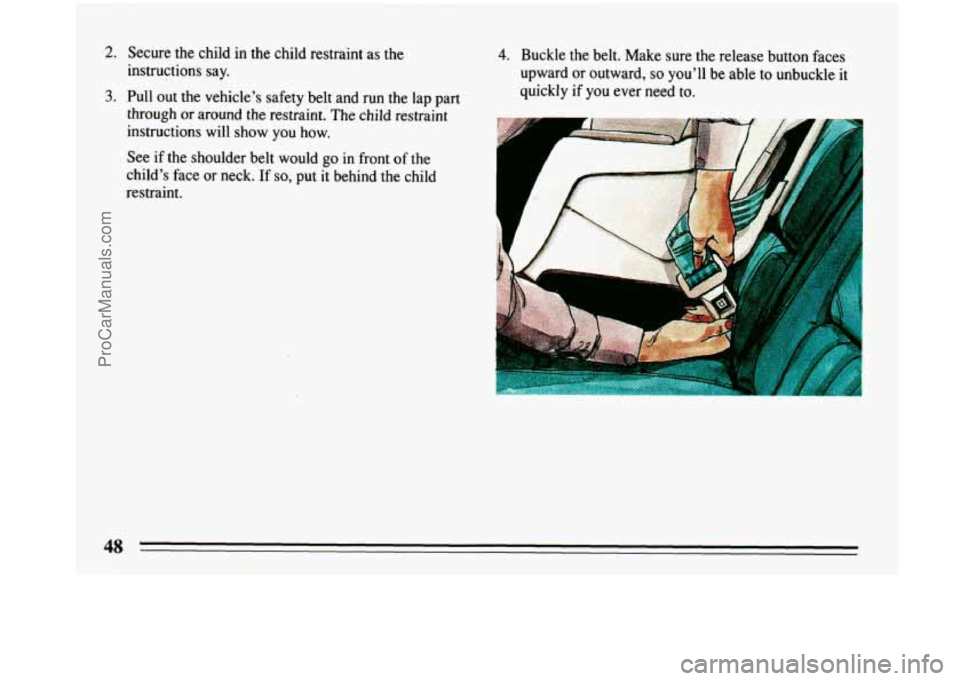
2. Secure the child in the child restraint as the
instructions say.
3. Pull out the vehicle’s safety belt and run the lap part
through or around the restraint. The child restraint
instructions will show you how.
See
if the shoulder belt would go in front of the
child’s face
or neck. If so, put it behind the child
restraint.
4. Buckle the belt. Make sure the release button faces
upward
or outward, so you’ll be able to unbuckle it
quickly
if you ever need to.
ProCarManuals.com